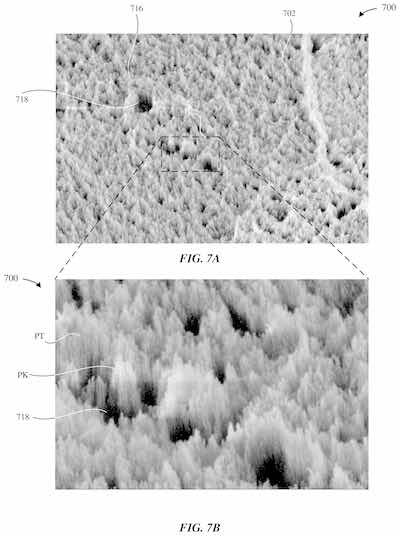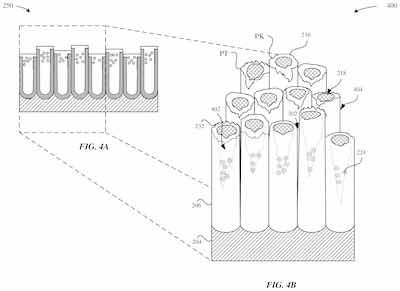Apple has received a U.S. patent on a new matte black anodizing finish that it could soon be adding to its product lines.
The patent approved by the U.S. Trademark and Patent Office is for an “anodized part having a matte black appearance.” The applicant listed for the patent is Apple Inc. and is credited to Apple researchers James Curran, Aaron Paterson, and Sonja Postak.
The patent says, “The anodized layer includes (i) an external surface that includes randomly distributed light-absorbing features that are capable of absorbing visible light incident upon the external surface, and (ii) pores defined by pore walls, where color particles are infused within the pores. The anodized layer is characterized as having a color having an L* value using a CIE L*a*b* color space that is less than 10.”
 Apple first introduced the matte black color option for iPhones in the iPhone 7, which was launched in September 2016., according to Chinmay Dhumal with mysmartprice.com.
Apple first introduced the matte black color option for iPhones in the iPhone 7, which was launched in September 2016., according to Chinmay Dhumal with mysmartprice.com.
“However, many users complained that the paint was chipping off, and the matte finish was not good compared to the high standards of Apple,” Dhumal wrote. “Hence, Apple has been quite conservative in releasing matte black options for its devices.”
Certain colors are far more difficult to achieve than others, writes patentlyapple.com.
“In particular, attempts by consumer electronic device manufacturers to achieve a true black color have fallen short,” patentlyapple.com writes. “This is what Apple’s invention has overcome.”
The approved patent — which was originally filed in 2020 — continues that it includes “a method for forming an enclosure for a portable electronic device, the method comprising: forming an anodized layer that overlays a metal substrate; infusing color particles within pores of the anodized layer; and forming light-absorbing features on an external surface of the anodized layer by etching the external surface” to get the L* value less than 10.
It says the “etched part 250 includes the light-absorbing features (LA) and the color particles 224 that together combine to impart the etched part 250 with a true black appearance. Accordingly, the anodized layer 206 can be quantified as having an extremely matte black appearance with an L* value of about 1, an a* value of about0, and a b* value of .about.0 using a CIE L*a*b* color space.”
 In addition, “At step 512, the external surface 202 of the sealed part 230 is subject to an etching process. The etching process is associated with stochastic etching of the pore walls 216 of the nanotubes 212 that causes the nanotubes 212 to have varied heights. The stochastic etching of the pore walls results in the external surface 202 of the anodized layer 206 having an extremely fine surface texture. The etched surface texture creates pits and peaks on the micron and sub-micron scale. According to some examples, the sealed part 230 is etched by exposing the sealed part 230 to a phosphoric acid solution. In some examples, the sealed part 230 is exposed to an 85% phosphoric acid solution at a temperature between about 65 degree - 70degree. Celsius from between about 15-30 seconds. In excess of 30 seconds, and the seal 232 typically begins to degrade while less than 15 seconds often fails to produce a sufficient amount of etching to form the light-absorbing features. It should be noted that etching a sealed anodized part represents a non-obvious departure from conventional anodizing processes. In particular, in conventional processes, etching is not performed subsequent to the sealing process as etching the sealed part 230 risks degrading the integrity of the seal 232. Furthermore, etching the external surface 202 of the sealed part 230 also reduces the amount of the hydrated material 226 that includes the seal 232; thereby, reducing resistance to corrosion. However, it should be noted that the external surface 202 subsequent to the etching still exhibits some corrosion resistance due to the seal 232 still being generally present.”
In addition, “At step 512, the external surface 202 of the sealed part 230 is subject to an etching process. The etching process is associated with stochastic etching of the pore walls 216 of the nanotubes 212 that causes the nanotubes 212 to have varied heights. The stochastic etching of the pore walls results in the external surface 202 of the anodized layer 206 having an extremely fine surface texture. The etched surface texture creates pits and peaks on the micron and sub-micron scale. According to some examples, the sealed part 230 is etched by exposing the sealed part 230 to a phosphoric acid solution. In some examples, the sealed part 230 is exposed to an 85% phosphoric acid solution at a temperature between about 65 degree - 70degree. Celsius from between about 15-30 seconds. In excess of 30 seconds, and the seal 232 typically begins to degrade while less than 15 seconds often fails to produce a sufficient amount of etching to form the light-absorbing features. It should be noted that etching a sealed anodized part represents a non-obvious departure from conventional anodizing processes. In particular, in conventional processes, etching is not performed subsequent to the sealing process as etching the sealed part 230 risks degrading the integrity of the seal 232. Furthermore, etching the external surface 202 of the sealed part 230 also reduces the amount of the hydrated material 226 that includes the seal 232; thereby, reducing resistance to corrosion. However, it should be noted that the external surface 202 subsequent to the etching still exhibits some corrosion resistance due to the seal 232 still being generally present.”



































